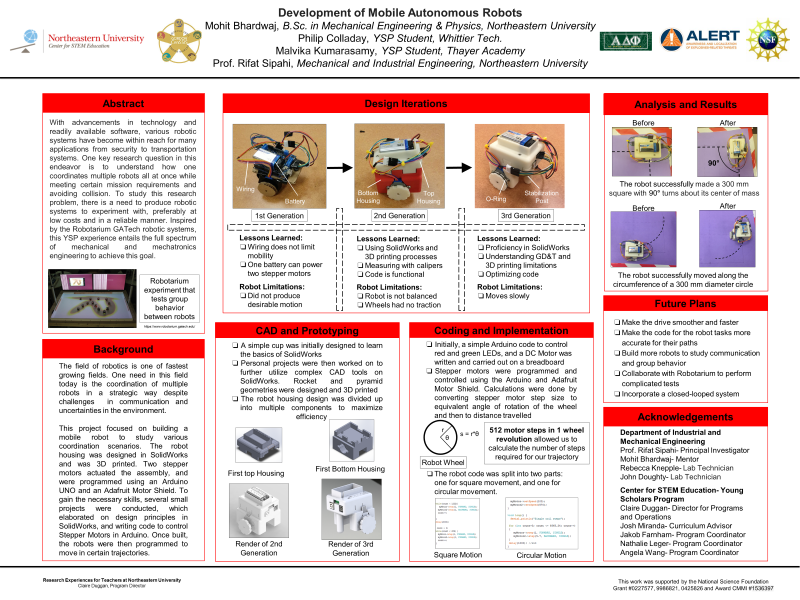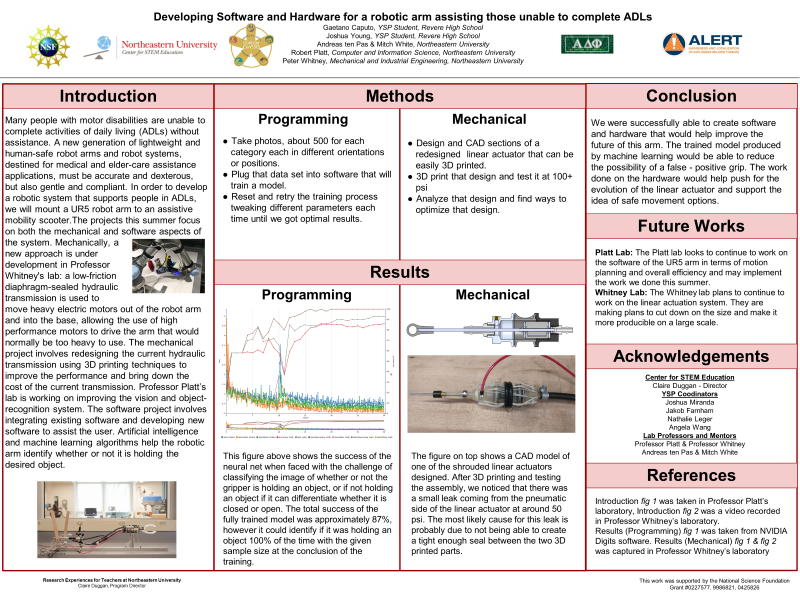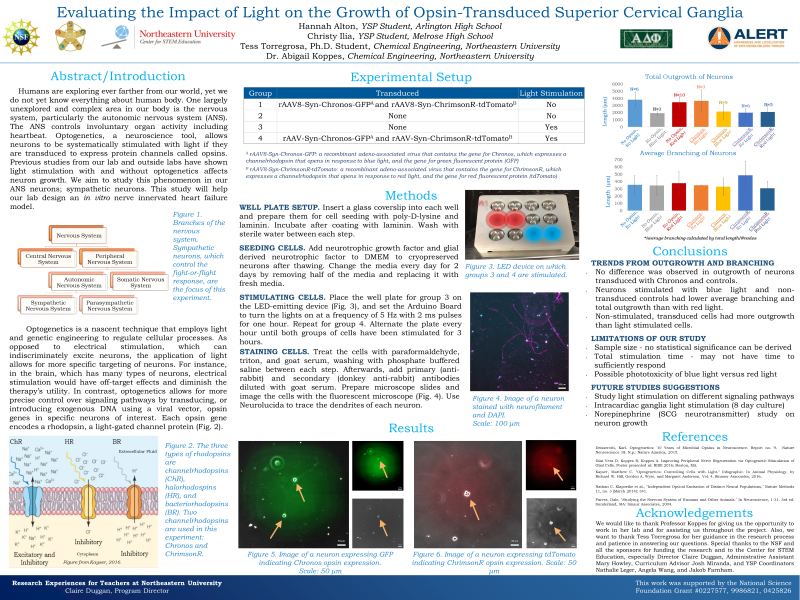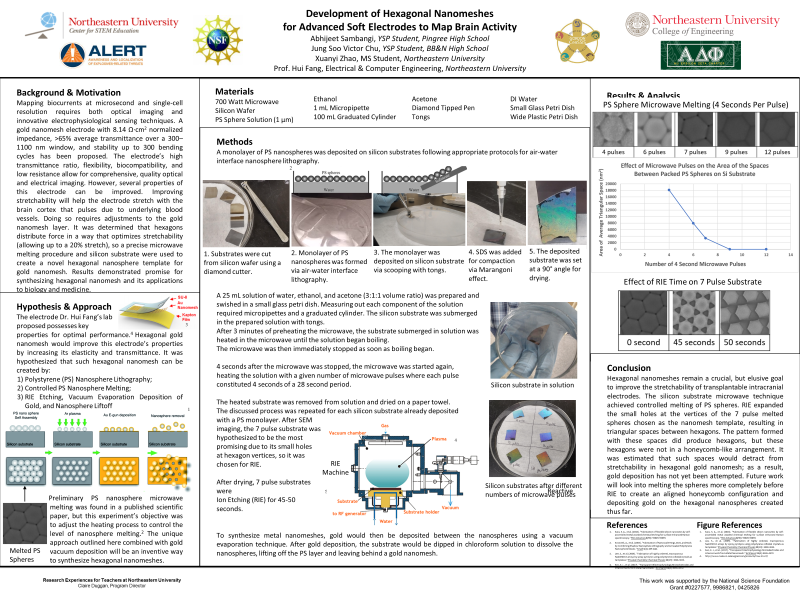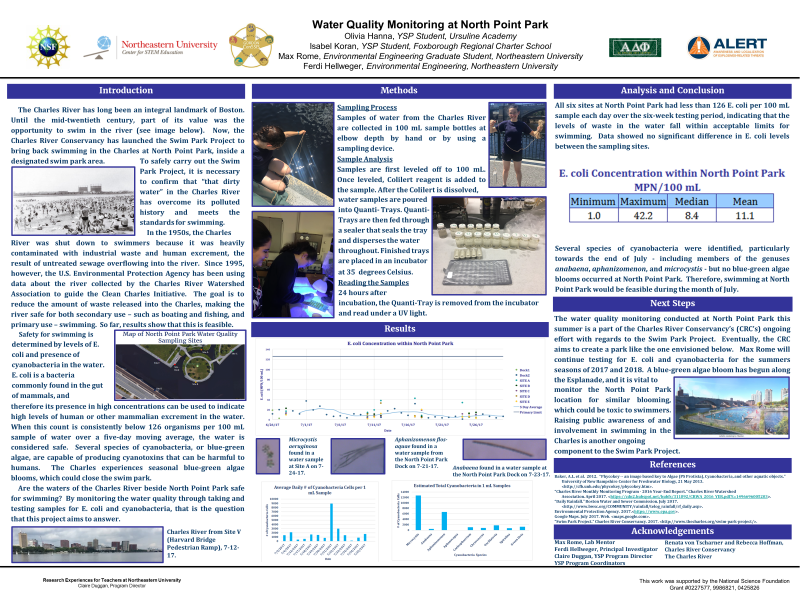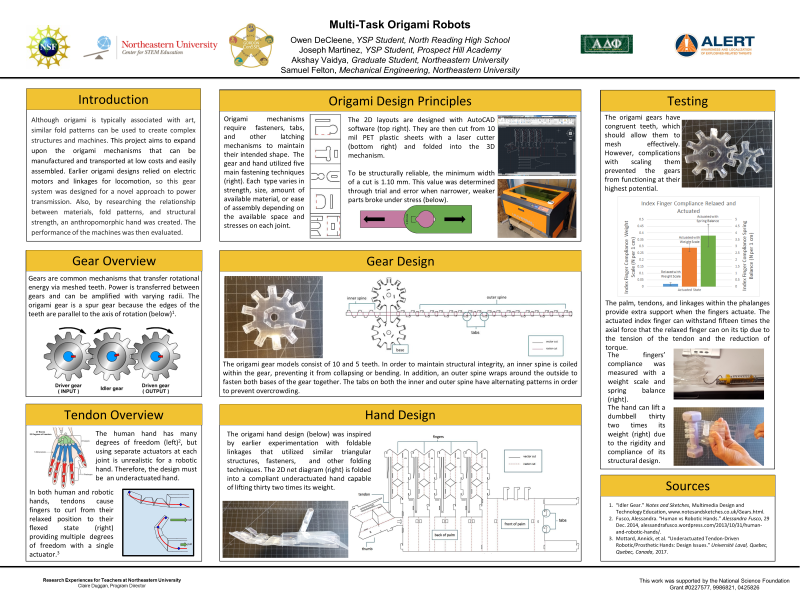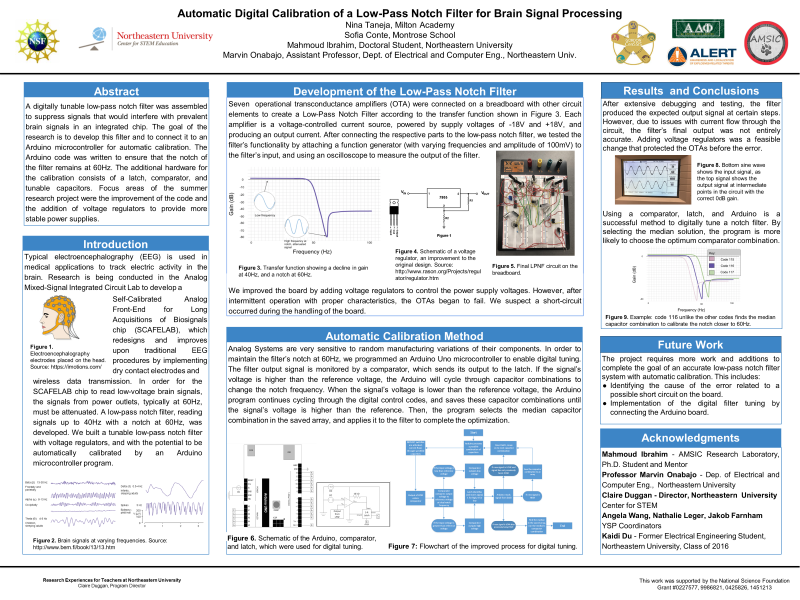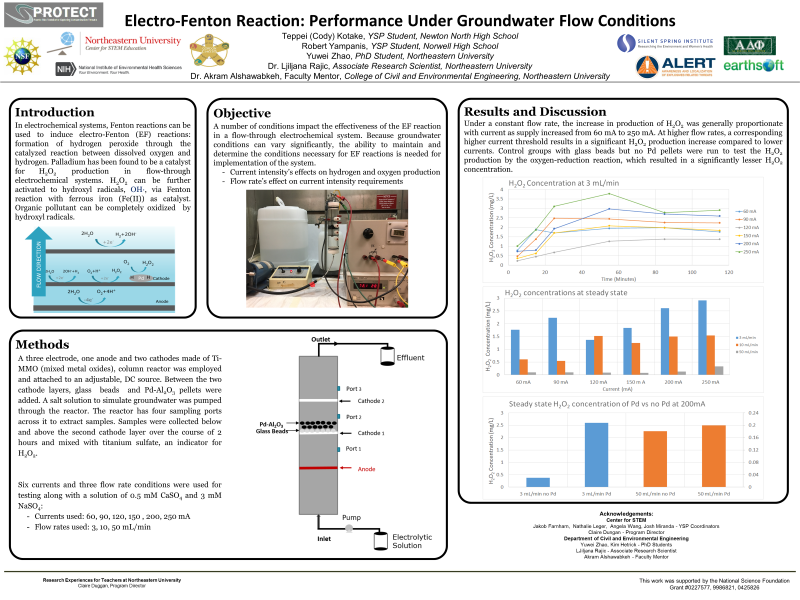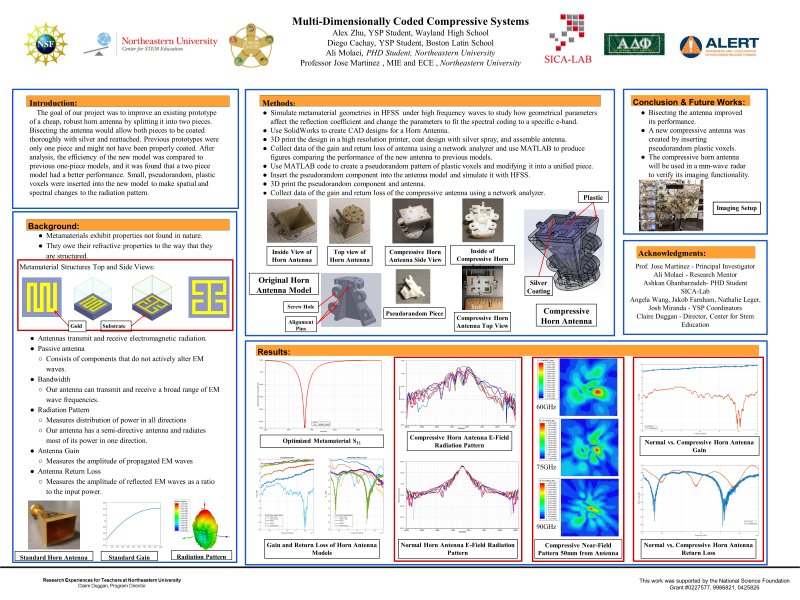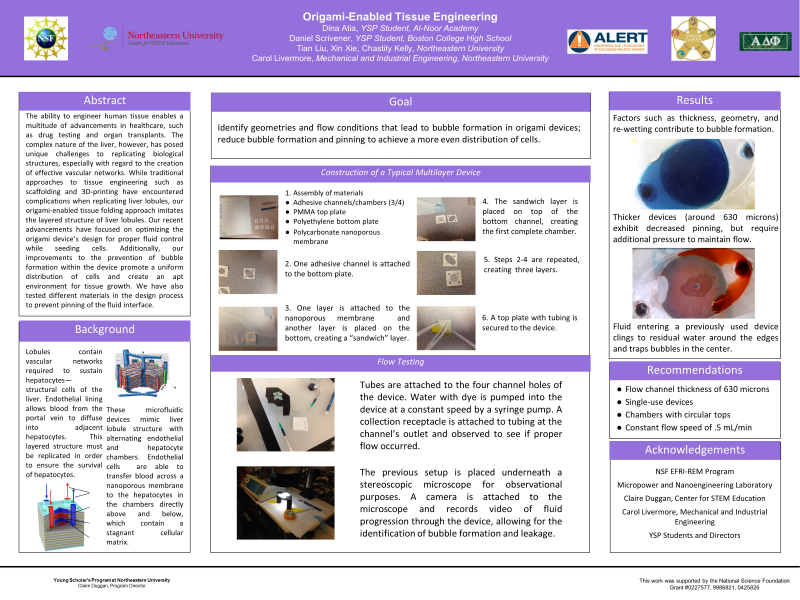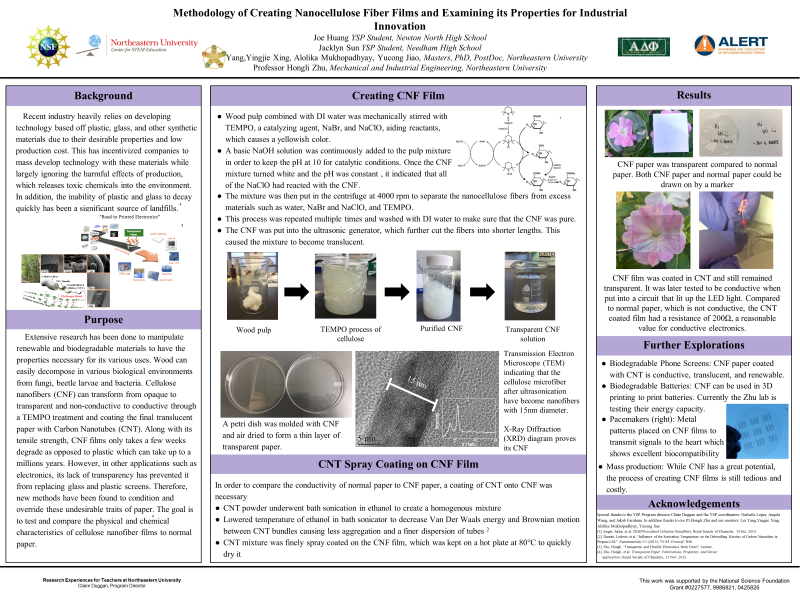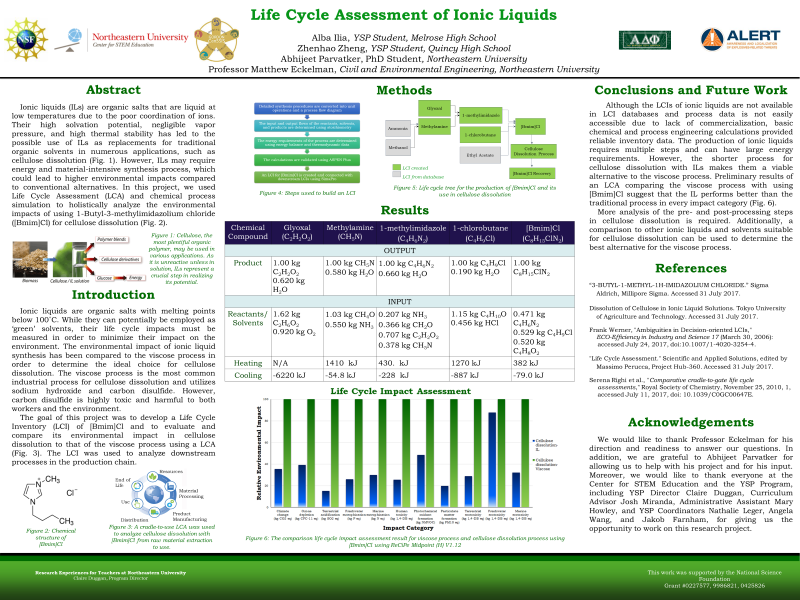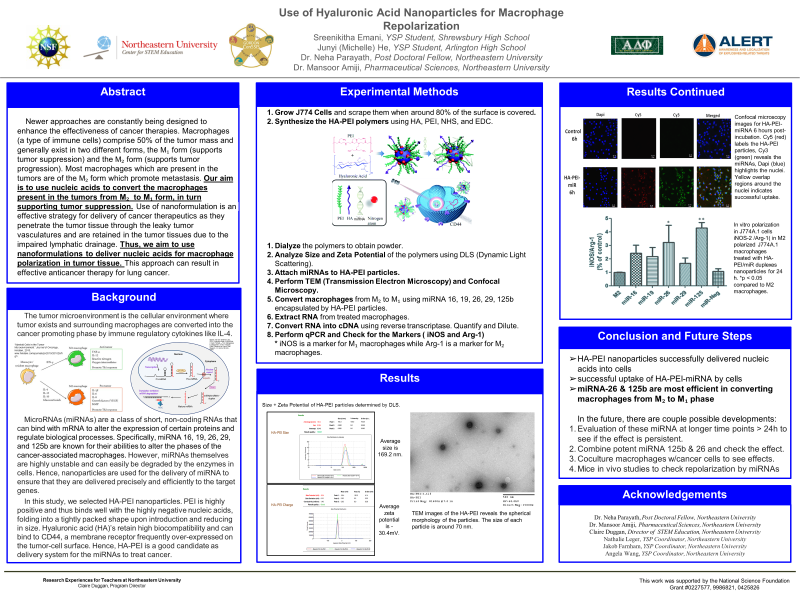YSP Alumni
Alumni Directory
2017 YSP Program Coordinators: Nathalie Leger and Jacob Farnham and Angela Wang
Participating Labs
| Lab | YSP Students | Title | Abstract |
|---|---|---|---|
| Faculty: Alshawabkeh, Akram Mentor: Ljiljana Rajic | Teppei (Cody) Kotake, Robert Yampanis | Electrochemical Groundwater Treatment | The PROTECT Center studies exposure to environmental contamination and its contribution to preterm births in Puerto Rico. As one of the PROTECT projects, our goal is to create a solar-powered electrochemical treatment of contaminated groundwater. Since around 40% of drinking water sources in US originate from groundwater, developing cost-effective and environmentally friendly approaches to remediate contaminated groundwater is imperative. In this project, we apply low direct electric currents through electrodes in wells to manipulate groundwater chemistry by electrolysis and create conditions to transform contaminants into harmless products. Our target contaminants are chlorinated solvents, specifically trichloroethylene (TCE), but the process is also designed to treat other common groundwater contaminants (e.g., pesticides, pharmaceuticals, heavy metals) and their mixtures. |
| Faculty: Amiji, Monsoor Mentor: Neha Parayath | Sreenikitha Emani, Junyi (Michelle) He | Nanoformulations in Treatment of Cancer and Inflammatory Diseases | Newer approaches are constantly being designed to enhance the effectiveness of cancer therapies. The tumor is formed of different types of cells such as immune cells and fibroblast along with the cancer cells. Macrophages which are a type of immune cells comprise 50% of the tumor mass. Macrophages generally exist in two different forms, the M1 form (supports tumor suppression) and the M2 form (supports tumor progression). Most macrophages which are present in the tumors are of the M2 form which helps in growth and metastasis of the tumors. Studies have shown that this M2 form can be converted to M1 form by use of certain nucleic acids. Our aim is to use these nucleic acids to convert the macrophages present in the tumors from M2 form to M1 form, in turn supporting tumor suppression. Use of nanoformulation is an effective strategy for delivery of cancer therapeutics. Nanosized formulations penetrate the tumor tissue through the leaky tumor vasculatures and are retained in the tumor tissues due to the impaired lymphatic drainage. Thus, we aim to use nanoformulations to deliver nucleic acids for macrophage polarization in tumor tissue. This approach when used in combination can result in effective anticancer therapy for lung cancer. |
| Faculty: Eckelman, Matthew Mentor: Mahdokt Montazeri | Alba Ilia, Zhenhao (Howard) Zheng | Network Models for Chemical Hazards and Emissions | Industrial production of chemicals is among the most energy- and emissions-intensive sectors of our economy. Regulatory frameworks for chemicals are moving from being largely risk-based to more holistic considerations of efficiency, resource use, and green chemistry. This National Science Foundation-funded project seeks to integrate chemical hazards such as toxicity, corrosivity, and volatility with systems-level assessment tools such as network analysis and life cycle assessment. The overall goal is to build a network model of chemical production in the United States that can be used to create projections for energy use and emissions and to map forward and backward dependencies in the network in order to evaluate resilience to supply chain disruptions. In all cases, the model will provide quantitative estimates of impacts to the environment, occupational safety, and public health. |
| Faculty: Felton, Samuel Mentor: Akshay Vaidya | Owen DeCleene, Joseph Martinez | Multi-task Origami Robots | Although origami is typically associated with art, we can use similar fold patterns to create useful structures and machines. In this project we will design a dual-purpose fold pattern that can be folded into either a four-legged walking robot or a robotic hand. To do this, we will research the relationship between materials, fold patterns, and structural strength. We will also study different actuation methods, including tendons, linkages, and electric motors, for precision, reliability, and efficiency. Finally, we will measure the performance of the machine in both states: the speed and carrying capacity of the walking robot, and the grip strength and adaptability of the hand. |
| Faculty: Fang, Hui Mentor: Xuanyi Zhao | Jung Soo (Victor) Chu, Abhijeet Sambangi | Advanced Soft Electrodes to Map the Brain Activity | Understanding perception and behavior, as well as diagnosing and treating brain diseases, would be greatly facilitated by the ability to record simultaneously from thousands of neurons in brain circuits. Single unit electrophysiology with microelectrodes has been the gold standard for monitoring brain activity in the sub-millisecond temporal range; however, it is difficult to scale up multielectrodes to monitor many thousands of neurons without causing damage to the brain. Optical approaches currently can record up to 100,000 neurons, but only with coarse temporal resolution, limited by the kinetics of the optical indicators of neural activity. While it is important to keep improving existing tools and technologies, it is equally important to encompass innovative combinations of existing technologies and to explore new concepts for multimodal recording and interrogation. In this project, we will develop advances soft electrode arrays to overcome the barrier in integrating electrical and optical brain mapping. |
| Faculty: Hellweger, Ferdi Mentor: Max Rome | Olivia Hanna, Isabel Koran | Nitrogen Import and Export from Lakes and Reservoirs | Nitrogen fertilizer use has increased rapidly over the past decades, leading to eutrophication of coastal waters, along with various associated problems: hypoxia, fish kills, harmful algal blooms etc. For example, the continental shelf along the northern Gulf of Mexico has become the second largest coastal hypoxic zone in the world (“The Dead Zone”), believed to be caused by increase of nitrogen load from the Mississippi River. One solution is to reduce nitrogen fertilizer use, but there may be a problem with this. A class of phytoplankton (cyanobacteria), which are increasing globally, may counteract this by fixing nitrogen from the atmosphere. This fixed nitrogen constitutes a new “source”, and costly fertilizer reductions may not have the expected effects. What is the relationship between external nitrogen input (fertilizer) and export (incl. fixed nitrogen) to/from lakes and reservoirs? Laboratory reactors will be set up to determine the quantitative relationship. The results will be used to develop models to evaluate the effect of nutrient reduction strategies. |
| Faculty: Koppes, Abigail Mentor: Tess Torregrosa | Hannah Alton, Christy Ilia | Evaluating the Impact of Light on the Growth of Opsin-Transduced Superior Cervical Ganglia | Humans are exploring ever farther from our world, yet we do not yet know everything about human body. One largely unexplored and complex area in our body is the nervous system, particularly the autonomic nervous system (ANS). The ANS controls involuntary organ activity including heartbeat. Optogenetics, a neuroscience tool, allows neurons to be systematically stimulated with light if they are transduced to express protein channels called opsins. Previous studies from our lab and outside labs have shown light stimulation with and without optogenetics affects neuron growth. We aim to study this phenomenon in our ANS neurons; sympathetic neurons. This study will help our lab design an in vitro nerve innervated heart failure model. |
| Faculty: Livermore, Carol Mentor: Tian Liu | Dina Atia, Daniel Scrivener | Origami-Enabled Tissue Engineering | Tissue engineering can save lives by supplementing the supply of organ transplants and by enabling the screening of new medical therapies before any human testing takes place. However, it is also incredibly complex. Tissues cannot survive without an adequate supply of nutrients and oxygen, or without removal of metabolic byproducts. Vascular networks provide these functions in most human tissues, but it has proven difficult to create effective vasculature in engineered tissues. A seemingly simple solution would be to seed cells onto a scaffold and let the developing tissue form its own vasculature, but research has shown that the resulting vascular networks are not sufficiently well-organized to supply the tissue. Despite the progress represented by this research, available techniques for tissue engineering are still limited by the need for serial processing (which limits throughput), an inability to produce truly 3D vascular networks, or both. The purpose of our research is to create tissue with excellent structural control and high throughput through a scalable process. The process involves a combination of assembling cells selectively onto 2D surfaces and folding 2D surfaces into 3D structures. (It’s possible to fold the 2D surfaces into 3D structures before assembling the cells, and this is one direction of our current research.) By combining 2D structuring with 3D architectures, we aim to create engineered tissue with structure that mimics that architecture of natural tissues. |
| Faculty: Martinez, Jose Mentor: Ali Molaei | Diego Cachay, Alexander Zhu | Standoff Detection of Security Threats using Millimeter Wave Radar at Millimeter Wave Frequencies | We are developing a new radar system concept, capable of detecting explosive related threats at standoff distances. The system consists of a two dimensional aperture of randomly distributed transmitting/receiving antenna elements and a set of Passive Reflecting Surfaces (PRS) positioned in the vicinity of the target. A 3D imaging algorithm, based on novel compressive sensing techniques, is used in this work. Preliminary results show that images having a resolution of 7.5 mm in cross-range and 30mm in range can be achieved at 10-40m range, when the radar works at 60GHz center frequency and has 6GHz bandwidth. |
| Faculty: Onabajo, Marvin Mentor: Mahmoud Ibrahim | Sofia Conte, Nina Taneja | Digitally Controlled Analog Circuits for Medical Applications | This project will make use of phase separation techniques to create polymer-nanofiller dispersions for carbon fiber precursor materials. The team is expected to correlate the phase separation conditions with the level of dispersion quality. |
| Faculty: Platt, Robert Mentor: Andreas ten Pas | Gaetano Caputo, Joshua Young | Open World Assistive Grasping on a Mobility Scooter | Many people with motor disabilities are unable to complete activities of daily living (ADLs) without assistance. In order to develop a robotic system that supports people in ADLs, we will mount a UR5 robot arm to an assistive mobility scooter. The scooter will be equipped with a variety of sensors such as RGB-D cameras and user interfaces that allow the user to select an object in the environment and make the robot pick it up. This project requires to integrate the arm and the mobile platform, and to develop software for that system. The former step requires to choose components that allow the system to be mobile. The latter step involves both integrating existing software and developing new software that assists the user. Next, we plan to validate the system in practice through a number of experiments in domestic environments. |
| Faculty: Sipahi, Rifat Mentor: Adrian Ramirez | Philip Colladay, Malvika Kumarasamy | Robotics Networks and their Coordination | This YSP is research is focused on building upon an existing experimental platform, to program several small scale robotic systems to generate certain robot coordination tasks, including incorporating a haptic robot to mimic a joystick in coordinating the robots. This is a hands-on research with strong foundations in system dynamics, control systems and mechatronics. |
| Faculty: Zhu, Hongli Mentor: Yucong Jiao | Jackyln Sun, Joe Huang | Nanocellulose from Trees | The goal of this study is to review the fundamental structures and chemistries of wood and wood-derived materials, which are essential for a wide range of existing and new enabling technologies. The scope of the review covers multiscale materials and assemblies of cellulose, hemicellulose, and lignin as well as other biomaterials derived from wood, in regard to their major emerging applications. Structure−properties− application relationships will be investigated in detail. Understanding the fundamental properties of these structures is crucial for designing and manufacturing products for emerging applications. Today, a more holistic understanding of the interplay between the structure, chemistry, and performance of wood and wood-derived materials is advancing historical applications of these materials. This new level of understanding also enables a myriad of new and exciting applications, which motivate this review. There are excellent reviews already on the classical topic of woody materials, and some recent reviews also cover new understanding of these materials as well as potential applications. This review will focus on the uniqueness of woody materials for three critical applications: green electronics, biological devices, and energy storage and bioenergy. |

